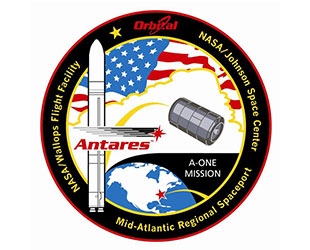April 21, 2013 — A commercial rocket designed to deliver cargo to the International Space Station (ISS) lifted off on its maiden test flight on Sunday (April 21), becoming the largest-ever booster to fly from Virginia's eastern coast.
Orbital Sciences launched its new Antares rocket from the Mid-Atlantic Regional Spaceport's (MARS) new Pad 0A at NASA's Wallops Flight Facility in coastal Virginia at 5:00 p.m. EDT (2100 GMT). The successful liftoff came on the third attempt, after scrubs for a loose data connection and high-level winds on Thursday (April 17) and Saturday (April 20), respectively.
The mission, dubbed by Dulles, Virginia-based Orbital as "A-ONE," put the 133-foot-tall (40 meters) Antares through its paces during the course of its ten-minute flight to clear the booster for its next major milestone — demonstrating the delivery of cargo and experiments to the space station later this year.
On this test flight, Antares was launched on a southeast trajectory with a dummy payload mimicking the weight of Orbital's Cygnus unmanned resupply spacecraft, a record-setting feat on its own.

Orbital Sciences' inaugural Antares rocket sits on the launch pad at the Mid-Atlantic Regional Spaceport in Virginia. (collectSPACE) |
"[It's] the biggest and loudest and brightest thing that has ever launched from Wallops," Frank Culbertson, a former NASA astronaut and the manager for advanced programs at Orbital, said in a pre-flight press conference.
A two-stage rocket, Antares incorporates both liquid and solid fuel stages. The first stage is powered by two rocket engines sourced from Russia and modified by Aerojet that were originally built in the late 1960s and early 1970s for the Soviet Union's ill-fated N-1 moon rocket.
The two Aerojet AJ26 liquid-fueled rocket engines, which began as Russian NK-33 engines, marked their first flight ever from U.S. soil on the Antares.
The second stage is a solid motor, Alliant Techsystems' (ATK) Castor 30, provided by the same company that built the solid rocket boosters that launched the space shuttle.
For the A-ONE test flight, the Cygnus cargo capsule was represented by a mass simulator, an 8,377 pound (3,800 kilograms) aluminum canister instrumented to monitor its flight into space. Cygnus is not designed to be recovered, and so like the real freighter it represents, the simulator will be destroyed when it re-enters the atmosphere, which Orbital expects to occur about two weeks after launch.
Antares also deployed a trio of coffee cup-size Phonesat satellites into orbit as part of a technology experiment for NASA Ames Research Center in California. Another small satellite the size of a bread box, called Dove-1, also rode with the rocket as part of a commercial agreement for the California-based company Cosmogia. Dove-1 is reportedly an Earth-observing satellite, per a NOAA remote-sensing license document.

The 8,300-pound Cygnus mass simulator for the A-ONE mission flies empty but was signed by Orbital's Antares team. (Orbital) |
Orbital has a $1.9 billion contract with NASA to fly eight Antares-Cygnus resupply flights to the International Space Station. The space agency awarded a similar, $1.6 billion contract to Space Exploration Technologies, or SpaceX, for 12 cargo delivery flights using that company's Falcon-Dragon launch vehicle and spacecraft system.
SpaceX has already flown two out of its dozen-contracted flights to date, after two successful demonstration flights.
"This is the culmination of a plan that we have been on for several years," Lori Garver, NASA's deputy administrator, said. "I am thrilled to have two competitors."
Orbital hopes to launch its second Antares flight as early as June, sending a packed Cygnus on a demo mission to the space station. The company's first contracted supply mission could then fly as early as September.
"Antares is our largest investment as a company and the Cygnus resupply is the largest contract we've achieved," said Culbertson.
Maiden mission patch
Following tradition, no mission would be complete without its own flight emblem, and Orbital's A-ONE test flight is no exception.

Orbital Sciences' Antares A-ONE test flight insignia. (Orbital) |
According to Orbital, the Antares A-ONE mission patch depicts the launch vehicle bisected by the program logo. A golden arc emerging from behind the rocket connects to the payload for this mission, a simulator that is roughly the same size and weight as the payload for its next nine missions, the Cygnus cargo spacecraft.
The A-ONE test flight flew from the Mid-Atlantic Regional Spaceport (MARS) at NASA Wallops Flight Facility, which is symbolized on the patch by a red star on the globe. The emblem's American flag carries dual symbolism: Antares is the nation's newest medium-class launch vehicle, and MARS is the nation's newest facility capable of launching both missions to the station as well as satellites into orbit.
The Orbital logo, as well as the names of the company's partners in developing Antares, the launch pad and the mission is emblazoned on the border of the design. The single gold star in the outer band of the patch, to the left of Orbital's logo, symbolizes A-ONE as the first mission in the company's space station delivery contract with NASA.
